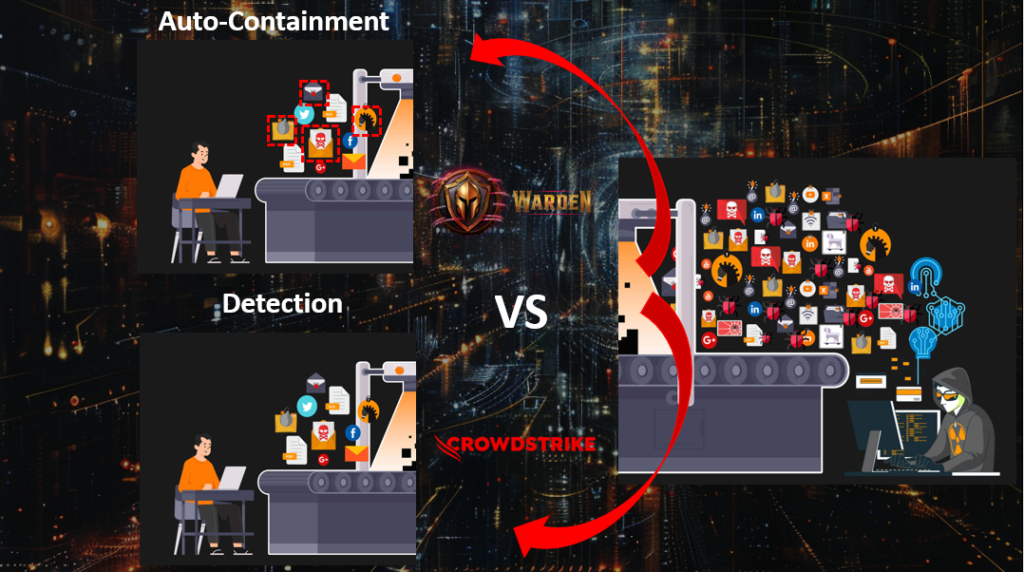Revolutionizing Endpoint Protection: Warden Zero Trust "Out-of-the-Box" Containment vs. CrowdStrike's Detection First Approach That Requires Frequent Kernel Updates
In today’s cybersecurity landscape, stability, security, and minimizing disruptions are paramount. Warden, by Cyber Strategy Institute, leverages the cutting-edge Zero Trust “Out-of-the-Box” endpoint security technology within our Managed Security Service Provider (MSSP) framework. This revolutionary approach utilizes kernel-level defense to auto-contain malware, ransomware, phishing or even exploit threats, offering a simplistic yet robust solution. Our strategy ensures protection and stability, setting us apart from traditional models.

The Flaws in CrowdStrike’s Approach
CrowdStrike’s frequent updates to kernel-mode code introduce significant risks and operational disruptions. Kernel-mode code, integral to the operating system, requires meticulous handling. Frequent updates can lead to system instability and crashes, exemplified by the recent Blue Screen of Death (BSOD) incident. This approach compromises system reliability and poses challenges for businesses dependent on stable IT environments.
Warden’s Unique Approach with Warden Zero Trust “Out-of-the-Box”
Warden Zero Trust “Out-of-the-Box” adopts a revolutionary strategy, eliminating the need for constant kernel updates through auto-containment. This approach ensures robust protection against both known and unknown threats, maintaining a stable and secure operating environment.
Patented Containment Technology: Our technology verifies all unknown executables in real-time, providing proactive protection. This Zero Trust architecture ensures that no file or process is trusted by default, isolating potentially harmful actions before they impact the system.
Latest and Stable Build Concept: Customers can choose between the latest and stable builds. This flexibility minimizes disruption, allowing businesses to benefit from the latest security enhancements without frequent updates. We release stable builds after extensive field testing, ensuring reliability.
Customer-Controlled Updates: Clients have complete control over updates, balancing the immediacy of new features with operational stability. Our containment-first approach ensures safety even with older releases.
Rigorous Testing: Our three-week testing period for new releases ensures stability and reliability. This thorough process significantly reduces the risk of bugs or compatibility issues, providing dependable solutions.
Adaptive Event Modeling: Unlike CrowdStrike’s static model, our Adaptive Event Modeling evolves without requiring intrusive updates. This approach allows for real-time threat response, maintaining high protection levels with minimal disruptions. By separating kernel-mode hook-in from user-mode telemetry collection, we ensure that only user-mode updates are needed for emerging threats, preserving system stability.
Prioritizing Prevention and Stability with Zero Trust Architecture
The current endpoint protection model must evolve from detection to prevention in order to stop all of these next generation threats in malware, ransomware, phishing and zero-day exploits. Warden’s containment and verification-first approach exemplifies this shift, reducing reliance on frequent kernel updates and mitigating associated risks. Our Zero Trust architecture provides a secure and stable environment, moving beyond the traditional update trap.
Comparison: Endpoint Security Protection Approaches of CrowdStrike Falcon vs. Warden
| Feature | CrowdStrike (Falcon) | Warden (Zero Trust) |
|---|---|---|
| Update Frequency | Frequent kernel-mode updates | Minimal kernel updates, focus on user-mode |
| Update Risks | High risk of system instability and crashes | Low risk, stability maintained through containment |
| Testing | Limited testing due to frequent updates | Extensive three-week testing period |
| Customer Control | Limited control over update timing | Full control over update timing |
| Threat Handling | Detection-based, reactive approach | Containment-based, proactive approach |
| Event Modeling | Static, requiring frequent updates | Adaptive, evolves without intrusive updates |
| System Impact | Higher system impact due to kernel updates | Lower system impact, user-mode focus |
| Reliability | Potentially less reliable due to update frequency | Highly reliable, thorough testing and stable releases |
Comparison of Endpoint Detection vs Auto-Containment: CrowdStrike Falcon vs. Warden
CrowdStrike Falcon (Falconview)
- Focus: Emphasizes advanced detection and response capabilities.
- Key Features Highlighted:
- Endpoint detection and response (EDR).
- Threat intelligence integration.
- Real-time monitoring and alerting.
- Frequent updates to stay ahead of threats.
- User Experience:
- Highlights rapid deployment and ease of use.
- Promotes a large ecosystem of integrations and API support.
Warden Zero Trust “Out-of-the-Box”
- Focus: Highlights proactive containment and zero-dwell time technology.
- Key Features Highlighted:
- Real-time auto-containment of unknown executables.
- Adaptive event modeling.
- Minimal system disruptions through controlled updates.
- Extensive testing to ensure stability.
- Endpoint detection and response (EDR).
- Threat intelligence integration.
- Real-time monitoring and alerting.
- Threat Hunting
- User Experience:
- Emphasizes customer control over updates.
- Promotes stability and reliability as core strengths.
Concise Differences
| Aspect | CrowdStrike Falcon | Warden |
|---|---|---|
| Approach | Detection and response | Containment and prevention |
| Update Strategy | Frequent kernel-mode updates | User-mode updates with extensive testing |
| Risk Management | Higher risk of system instability | Lower risk, emphasis on stable environments |
| Customer Update Control | Limited | Full control, flexibility in update timing |
| System Stability | Potential disruptions due to frequent updates | High stability through containment-first approach |
| Event Modeling | Static | Adaptive, evolves without frequent updates |
Summary
CrowdStrike Falcon emphasizes a detection and response approach with frequent updates and real-time monitoring, which can lead to potential system instability. In contrast, Warden focuses on proactive containment, minimizing kernel updates, and ensuring high system stability and customer control. The user experience with Warden is tailored to provide reliability and control, whereas CrowdStrike promotes rapid deployment and a broad integration ecosystem.
In conclusion, Warden Zero Trust “Out-of-the-Box” approach, offers a revolutionary endpoint protection solution within our MSSP framework. By prioritizing stability, security, and customer control, we deliver unparalleled protection and operational reliability. Let’s embrace this forward-thinking approach and ensure a secure and stable future for our systems.





